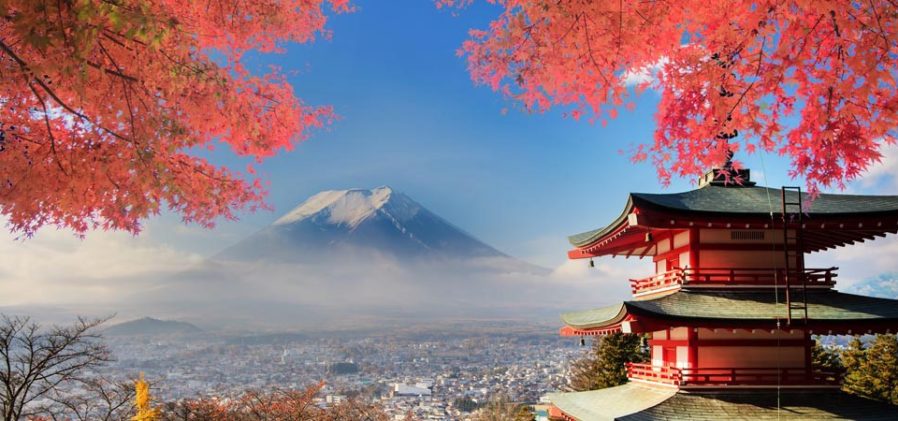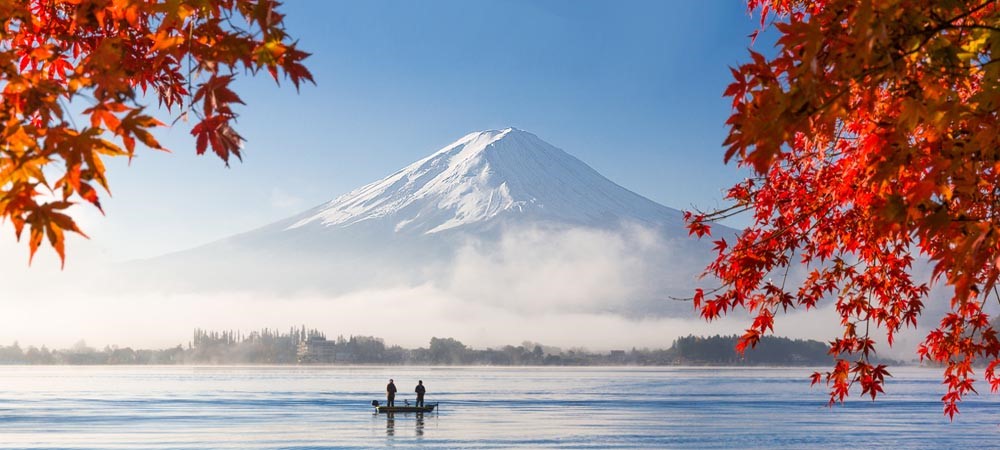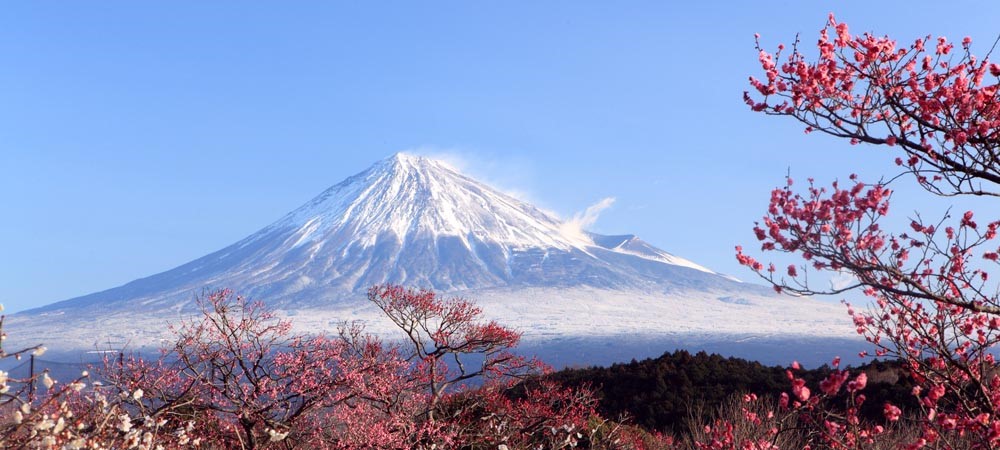It’s easy to think of certain imagery when Japan comes to mind – the neon lights of Tokyo, the strange but wonderful futuristic experiences such as the Robot Cafe, the colourful and sometimes bizarre costumes of Harajuku and of course the world famous Mount Fuji. While many people come to explore the unique streets of futuristic Tokyo, the deep history behind the likes of Hiroshima coupled with enjoying both Hanami and Yozakura at the right times of year, many others come to challenge themselves by climbing one of the world’s most famous active stratovolcanoes.
But what’s the story behind this famous Japanese landmark? How do you go about climbing it and ticking it off your bucket list? Here is a brief history of this famous sight as well as a short guide to climbing one of the most prominent mountains in Japan – as well as the world.
Mount Fuji – A History
Since ancient times Mount Fuji was thought to be sacred, with the first recorded ascent taking place in what is thought to be 663 by a monk who remained anonymous. In Shinto mythology Konohanasakua-hime, the wife of Ninigi, is believed to be the goddess of Mount Fuji. The Fujisan Hongu Sengen Taisha, a beautiful shrine, is dedicated to her and became a hugely popular destination throughout time as a place of worship and pilgrimage. Initially built in the reign of Emperor Keiko, the grounds of the shrine are considered to stretch all the way up the mountain and incorporate the whole summit of Mount Fuji. Pilgrimages by ascetic monks who climbed Mount Fuji were done around this time and increased in popularity through the ninth century, although women were typically forbidden to climb the mountain at all until the rather late Meiji Period, circa the late 1860s.
Throughout subsequent periods such as the Kamakura period, many visitors to the shrine and the surrounding area brought with them practices that remain to this day. The Shogun Minamoto no Yoritomo came by frequently during various expeditions and throughout the war games he staged near and around the mountain, which brought the tradition of horse mounted archery – or yabusame – to the festivals held at the shrine which continue to this day, annually on May 5th. As time went on, the popularity of the shrine increased and during the Muromachi period many clans visited the area, some of which – namely the Tokugawa clan – left large sums of money as offerings following battle victories which helped to keep the shrine in very good condition for many years.
By the time the Edo period came around, cult worshiping at the shrine was an all time high and pilgrimages were frequent. The first stop on any ascent up Mount Fuji, pilgrims would wash in the holy water at the shrine in order to purify themselves before the climb. To this day one of the first stops up the mountain is the Fujisan Hongu Sengen Taisha, where people continue the ritual of purification and asking for blessings of a safe climb up the mountain.
The shrine was added to the UNESCO World Heritage List as part of the overall Fujisan Cultural area in 2013 and was listed as one of the main government supported shrines in Japan from 1871 through to 1946, helping to maintain its importance and led to a number of protected sites within the shrine grounds including the large pond and head of the Fuji River, Wakutama-ike.
Mount Fuji Today
Today Mount Fuji stands tall and majestic as ever and continues to be one of the biggest tourist hot-spots in Japan. Drawing people from around the world to both admire it from afar as well as those brave enough to attempt to ascend the 12,400 feet to the summit, Mount Fuji is as popular today as it was hundreds of years ago. Viewing Fuji from afar can create imagery that remains quintessentially Japanese, what with the cherry blossoms blooming on lake-sides in the spring, creating an iconic image that draws visitors from across the globe. In this sense, Mount Fuji continues to enjoy popularity to this day, just as much as it did hundreds of years ago.
Climbing Fuji today is a popular activity done by many tourists who come to Japan. A climb typically begins with a stop at the shrine before the main trailheads at the 5th station in order to pray for a safe and prosperous hike and to give offerings to the spirits of the mountain. As Mount Fuji is believed still to this day to be sacred, it’s an important aspect of any ascent up the mountain to stop and take a moment of reflection on what you’re about to embark upon.
It’s at the fifth station that the four trail-heads – and therefore the bulk of the climb – begin. The four trails include: Yoshida Trail (starting at 2300 meters and taking 5-7 hours); Subashiri Trail (starting at 2000 meters and taking 5-8 hours); Gotemba Trail (starting at 1400 meters and taking 7-10 hours); and Fujinomiya Trail (starting at 2400 meters and taking about 5-7 hours). While there are no real huge challenges that befall climbers on their way to the summit, it’s suggested that you take it easy and rest when necessary and to stop overnight if altitude begins to bother you. The trails in spots can be rocky and uneven, but overall they are clearly marked and easily accessible for most levels of fitness and ages and so can be attempted successfully by most people.
Each trail offers climbers the opportunity to stay in mountain huts in order to break up the journey as well as to catch your breath as the oxygen gets thinner and thinner the higher you go. The risk of altitude sickness also increases the higher you climb, so the huts provide a much needed respite overnight with culinary offerings as well. A stay in the huts ranges from around 5,000-7,000 yen ($50-$70) with two meals, or 1,000-2,000 yen if just stopping off for a rest and a cup of tea. Camping independently on the mountain is absolutely not allowed and you should be prepared to take anything home that you brought with you as there are no garbage facilities on the mountain, either.
When To Climb Mount Fuji
There is only a very short window during which you can climb Mount Fuji – unless of course you possess high level alpine climbing experience and have the necessary gear. The window is typically from early July through to September 10, at which point the weather begins to turn and can make climbing to such high altitudes not just a chilly experience, but also treacherous thanks to strong winds and highly changeable weather conditions. As a result, the climbing season is narrow, and attracts a huge number of visitors from around the world. While climbing the mountain in the off season can be an extraordinary experience – having almost the whole place to yourself, there is something to be said for the people you can meet on the trails and in the tea houses, joining forces and engaging in conversation and creating friendships while you all tackle Japan’s highest peak together.
In terms of the time of day to climb the mountain, many people prefer to view the sunrise from the summit and so climb when it’s still dark out in order to get to the summit for the impressive sunrise. It’s also more likely to be clear visibility early in the morning at the top during peak climbing season, so this is a popular option for those wanting to catch the impressive view.
Imperative Equipment to Climb Mount Fuji
If you’re thinking about tackling a climb of Mount Fuji you will need to make some preparations in advance of heading to Japan. Taking precautions as to the things you pack will ensure your hike is enjoyable and you are successful at reaching the summit both safely and comfortably. Here is a short list of things you should consider bringing with you when you embark on your trip to tackle this prominent mountain.
- Proper hiking boots/shoes. The winds can be strong and the paths can be rocky and uneven so having proper shoes or boots designed for hiking varied terrain will make your climb much more safe and comfortable. Consider breaking in new boots or shoes prior to your trip for maximum comfort.
- Proper clothing. It can be frigid at the summit, even in summertime, so consider bringing wind and waterproof gear as well as sweaters or fleece jackets – something that you can throw on when the temperature dips, especially if you’re planning to climb through the night for sunrise.
- This will keep your hands free and is imperative if you’re climbing in the night. While there may be many others climbing through the night and the light from their flashlights may be sufficient, it’s good to have your own in case you find yourself in an area without many people.
- Imperative if you need to stop overnight due to altitude or purchase other supplies like canned oxygen. Also needed to use the toilets on the way up and down the mountain.
- Food and water. Water is important, however the food can be sometimes considered optional depending on the trail you’re taking. Some trails don’t have as many huts offering meals as other trails, so being prepared is important. Also the price of meals increases the higher you get, so make sure you have sufficient money if you’re not bringing anything past snacks for the climb.
If climbing Mount Fuji sounds like something you’d like to tackle and experience, consider booking your excursion through Explorient’s Mount Fuji Climb Expedition tour which includes transfers, accommodation, and mountain guides, available between July and August.
Other recommended adventure tours by Explorient:
- The Ultimate Borneo Adventure – Malaysia Borneo, Sukau, Danum Valley, Kota Kinabalu
- Thailand Trekking Adventure – Chiang Mai, Chiang Rai, Hill Tribe Stay
- Trekking Tour of Northern Vietnam’s Sapa Region – Hanoi, Halong Bay Cruise, Luxury Train, Sapa







